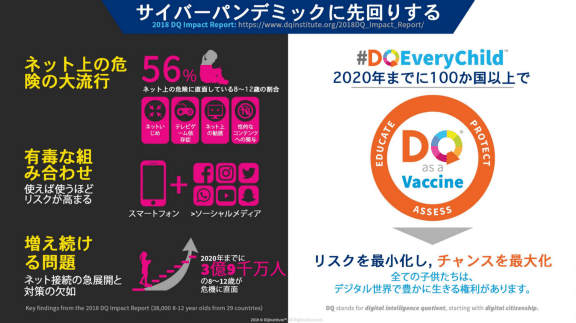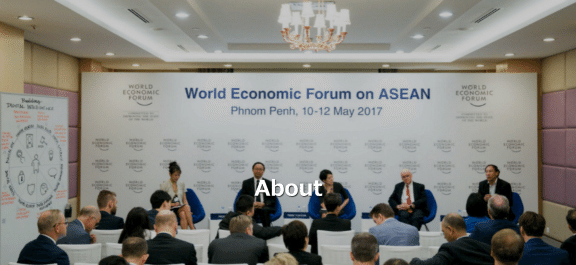
【2018 DQ Impact Report ⓪】サイバーパンデミックに先回りする:すべての子どもたちにDQを
当コンテンツの内容、テキスト、画像等の無断転載・無断使用を固く禁じます。また、NAVERまとめ等のまとめサイトへの引用を厳禁いたします。
Unauthorized copying and replication of the contents of this site, text and images are strictly prohibited.
2018 DQ Impact Report: https://www.dqinstitute.org/2018dq_impact_report/
「テクノロジーは子供たちにとって良いのか悪いのか?」
この質問は親の間で議論が分かれている。子供たちに iPhone の有害な影響についての最近の論争と、学校でスマートフォンを禁止するというフランス政府の新しい決定は、デジタルメディアとテクノロジーの子供への影響について世界的な議論を巻き起こしている。
実際には、この質問は尋ねるべきでない質問かもしれない。テクノロジーは既に子供たちのデジタル生活に欠かせない。デジタル世界にアクセスすることができるのは、21世紀における子供たちの基本的な権利の一つである。
上記の質問のジレンマに苦しむのではなく、子供たちの生活の中でテクノロジーの潜在的な可能性も示唆されるべきです。よって、より重要な質問は以下のようになるだろう。
「私たちの子供たちは、ネット上のリスクを最小化しつつ、テクノロジーのチャンスを最大化するためのデジタルスキルを備えているだろうか?」
その疑問に答えるのが2018 DQ Impact Report(以後、報告書)である。世界中の子供たちが直面しているネット上のリスクの不安定な状態を調べ、ネット上のリスクにどのように曝されるか、そしてこれらのリスクが子供にどのように影響するかを理解できるようにする。
報告書は8歳から12歳の子供たちに焦点を当てており、その理由としては、この年齢層がデジタルメディアやデバイスを積極的に使用し始めながら、自己のアイデンティティ、将来の行動および人間関係に長期的な影響を及ぼすデジタル習慣を形成し始めるからである。
さらに重要なことに、報告書は、すべての子供たちがデジタル化が進む未来において生き抜くための基本的な保護、権利、平等な機会を有する「倫理的デジタルエコシステム」を構築することの重要性を唱え、保護者、教師、コミュニティ、ICT企業、政府などすべてのステークホルダーと協力しながらどのようにその環境を実現していくか言及している。また、報告書では、#DQEveryChild(#すべての子供たちにDQを)を使用してリスクを軽減し、チャンスを最大化するデジタルスキルを子供に与えるための実用的なソリューションを提案する。

報告書は以下のセクションで構成されている。
The Challenge
*注:ICT先進国を、ブロードバンド普及率20%以上、1人当たり2万ドル以上のGDPを持つICT開発の歴史が長い国として定義した。他はICT新興国として考える。
The Strategy
The Impact
・・・

Acknowledgements
The 2018 DQ Impact Report is an annual report summarizing the state of online safety and digital citizenship of 8–12 year olds around the world and reviewing the impact of #DQEveryChild in improving digital citizenship among children.
The 2017 DQ Impact Study was conducted as part of the #DQEveryChild initiative and included 37,967 8–12 year old study participants across 29 countries. The Study is one of the first large-scale, multi-national projects investigating online behaviours, exposure to cyber-risks, and digital citizenship levels among 8–12 year old children.
Methodology
Participants
We collected data from 29 countries including Argentina, Australia, China, Dominican Republic, Ecuador, Egypt, India, Indonesia, Italy, Japan, South Korea, Malaysia, Mexico, Nepal, New Zealand, Nigeria, Oman, Peru, Philippines, Qatar, Singapore, South Africa, Spain, Thailand, Turkey, United Kingdom, United States, Uruguay, and Vietnam. 50% of the participants were female and the ages of the participants ranged from 8–12 years. 26% of participants were 12 year olds, 30% were 11 year olds, 25% were 10 year olds, and 19% were 9 and 8 year olds. The children participated through their schools, either in the classroom or at home on the website where the survey was hosted. Participants were recruited by the students’ teachers and administrators. There was no incentive offered for participation.
Materials
The data was collected through two different mediums, the online platform DQWorld.net and the DQ student survey. The DQ student survey was a shortened form of the one used on DQWorld.net in order to be able to assess similar risks in less time. All questions in the student survey are available on DQWorld.net. The survey was created to assess risk across multiple areas, including gaming addiction, cyberbullying, online sexual content, and meeting online strangers. The DQ Student survey consisted of 81 questions which were taken from the larger DQWorld.net questionnaire of 295 questions. The data was collected from March 2017 to November 2017 across both platforms. The student survey was distributed to students by their teachers to either fill out in class or at home later. In some countries, pen and paper surveys were given out, with results coded and sent by teachers.
Procedures
Students were recruited through the aid of teachers and school administrators who were contacted by partners located in each country. The amount of time required to fill out each of the DQ student surveys is around 60 minutes and the amount of time to complete the activities on DQWorld.net is around 10 hours. In the beginning, students were told that we would be assessing their Digital Intelligence and that they would receive a score to see how they compared to their school and country average. Survey questions were then matched with those from DQWorld.net to allow us to combine the data.
Limitations
There are some limitations of this Study. As the Study was conducted as part of the #DQEveryChild initiative, the participants were selected at convenience and the number of participants from each country varied depending on the extent of the initiative’s adoption in that country. Thus, while the results are statistically significant, there are limitations in claiming that results obtained in each country are fully representative of that country.
Reference
1. Benoit, D (2018, Jan 07) iPhones and Children Are a Toxic Pair, Say Two Big Apple Investors. Retrieved from: link
2. Willsher, K. (2017, Dec 11) France to ban mobile phones in schools from September. link
3. The State of the World’s Children 2017. (2017, December 11). Retrieved January 17, 2018, from link
4. FACT SHEET: A summary of the rights under the Convention on the Rights of the Child Retrieved January 17, 2018, from link
5. “Statistics.” ITU, link
6. “Gross Domestic Product 2016.” World Bank, link
7. American Academy of Pediatrics Announces New Recommendations for Children’s Media Use. Retrieved January 17, 2018, from link
8. Swing, E. L., Gentile, D. A., Anderson, C. A., & Walsh, D. A. (2010). Television and video game exposure and the development of attention problems. Pediatrics, 126(2), 214–221.
9. Russo, M., Bergami, M., and Morandin, G.,. (n.d.). Surviving a Day Without Smartphones. Retrieved January 17, 2018, from link
10. LaFrance, A. (2017, July 25). The Algorithm That Makes Preschoolers Obsessed With YouTube. Retrieved January 17, 2018, from link
11. Child Development. (2016, March 15). Retrieved January 17, 2018, from link
12. Mah, V. K., & Ford-Jones, E. L. (2012). Spotlight on middle childhood: Rejuvenating the ‘forgotten years’. Paediatrics & child health, 17(2), 81–83.
13. Rosen, L., Carrier, L. M., Miller, A., Rokkum, J., & Ruiz, A. (2016). Sleeping with technology: cognitive, affective, and technology usage predictors of sleep problems among college students. Sleep Health: Journal of the National Sleep Foundation, 2(1), 49–56.
14. Woods, H. C., & Scott, H. (2016). # Sleepyteens: social media use in adolescence is associated with poor sleep quality, anxiety, depression and low self-esteem. Journal of adolescence, 51, 41–49.
15. Gentile, D. A., Berch, O. N., Choo, H., Khoo, A., & Walsh, D. A. (2017). Bedroom media: One risk factor for development. Developmental psychology, 53(12), 2340.
16. Ali, S. (2016). Relationship Between Technology Use and Development of Social Skills (Doctoral dissertation, California State University, Northridge).
17. Bergman, S. M., Fearrington, M. E., Davenport, S. W., & Bergman, J. Z. (2011). Millennials, narcissism, and social networking: What narcissists do on social networking sites and why. Personality and Individual Differences, 50(5), 706–711
18. Burke, M., Marlow, C., & Lento, T. (2010, April). Social network activity and social well-being. In Proceedings of the SIGCHI conference on human factors in computing systems (pp. 1909–1912). ACM.
19. Rosen, L. D., Whaling, K., Rab, S., Carrier, L. M., & Cheever, N. A. (2013). Is Facebook creating “iDisorders”? The link between clinical symptoms of psychiatric disorders and technology use, attitudes and anxiety. Computers in Human Behavior, 29(3), 1243–1254.
20. Van Geel, M., Vedder, P., & Tanilon, J. (2014). Relationship between peer victimization, Cyber-bullying, and suicide in children and adolescents: a meta-analysis. JAMA pediatrics, 168(5), 435–442.
21. Gámez-Guadix, M., Orue, I., Smith, P. K., & Calvete, E. (2013). Longitudinal and reciprocal relations of Cyber-bullying with depression, substance use, and problematic Internet use among adolescents. Journal of Adolescent Health, 53(4), 446–452.
22. Bushman, B. J., Gollwitzer, M., & Cruz, C. (2015). There is broad consensus: Media researchers agree that violent media increase aggression in children, and pediatricians and parents concur. Psychology of Popular Media Culture, 4(3), 200–214.
23. Vernon, L., Barber, B. L., & Modecki, K. L. (2015). Adolescent problematic social networking and school experiences: the mediating effects of sleep disruptions and sleep quality. Cyberpsychology, Behavior, and Social Networking, 18(7), 386–392.
24. Al-Menayes, J. (2014). The relationship between mobile social media use and academic performance in university students. New Media and Mass Communication, 25, 23–29.
25. Sampasa-Kanyinga, H., & Lewis, R. F. (2015). Frequent use of social networking sites is associated with poor psychological functioning among children and adolescents. Cyberpsychology, Behavior, and Social Networking, 18(7), 380–385.
26. Rosen, L. D., Lim, A. F., Felt, J., Carrier, L. M., Cheever, N. A., Lara-Ruiz, J. M., … & Rokkum, J. (2014). Media and technology use predicts ill-being among children, preteens and teenagers independent of the negative health impacts of exercise and eating habits. Computers in human behavior, 35, 364–375.
27. Park, Y. (2016, June). 8 digital skills we must teach our children. Retrieved January 17, 2018, from link
28. Park, Y. (2016, September). 8 digital life skills all children need — and a plan for teaching them. Retrieved January 17, 2018, from link
29. Empower Children with 8 Digital Citizenship Skills in 5 Days! (2017, September). link
30. Singapore and Australia First to Launch DQ Institute Cyber-risk Reporting System for Children. (2017, September) Retrieved January 17, 2018, from link
31. DQImpact (Part 2). Retrieved January 17, 2018, from link
2018 DQ Impact Report: https://www.dqinstitute.org/2018dq_impact_report/
この記事が気に入ったらサポートをしてみませんか?
